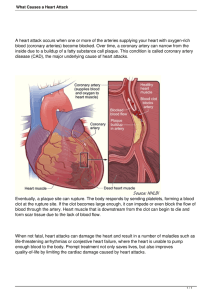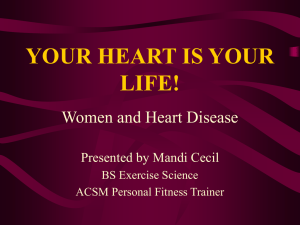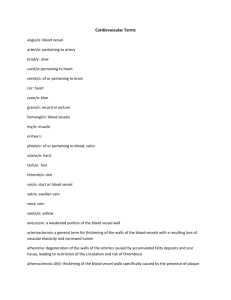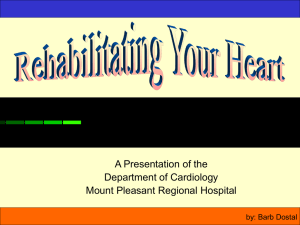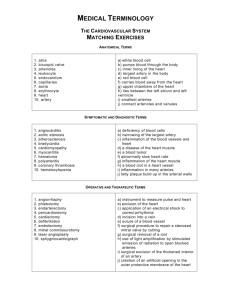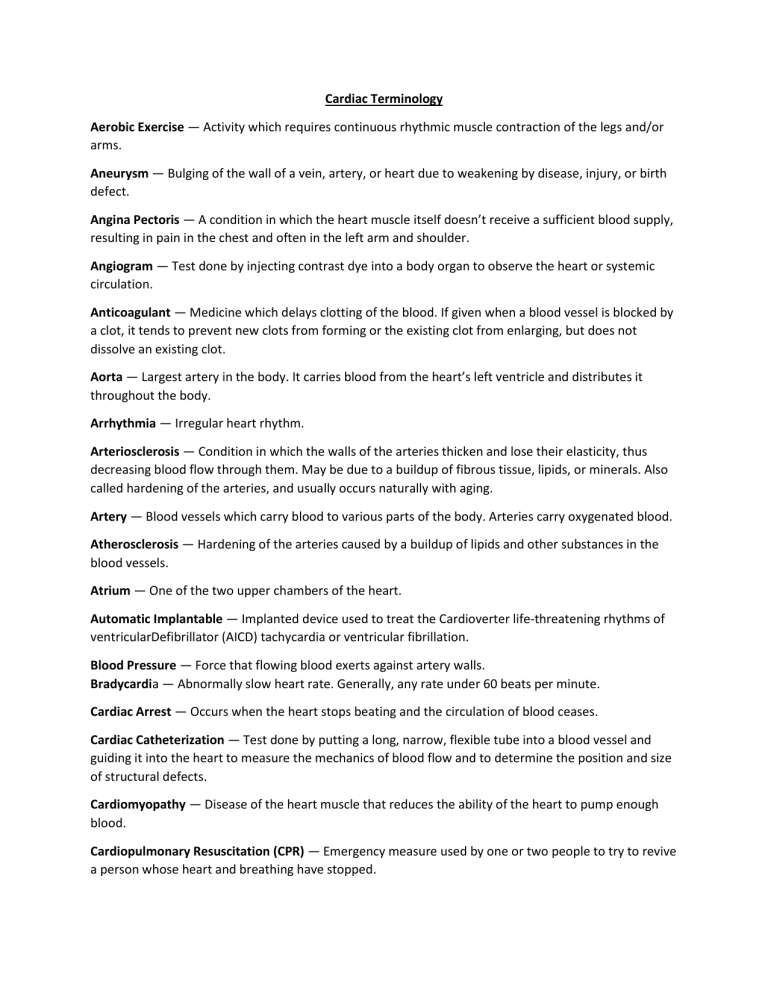
Cardiac Terminology Aerobic Exercise — Activity which requires continuous rhythmic muscle contraction of the legs and/or arms. Aneurysm — Bulging of the wall of a vein, artery, or heart due to weakening by disease, injury, or birth defect. Angina Pectoris — A condition in which the heart muscle itself doesn’t receive a sufficient blood supply, resulting in pain in the chest and often in the left arm and shoulder. Angiogram — Test done by injecting contrast dye into a body organ to observe the heart or systemic circulation. Anticoagulant — Medicine which delays clotting of the blood. If given when a blood vessel is blocked by a clot, it tends to prevent new clots from forming or the existing clot from enlarging, but does not dissolve an existing clot. Aorta — Largest artery in the body. It carries blood from the heart’s left ventricle and distributes it throughout the body. Arrhythmia — Irregular heart rhythm. Arteriosclerosis — Condition in which the walls of the arteries thicken and lose their elasticity, thus decreasing blood flow through them. May be due to a buildup of fibrous tissue, lipids, or minerals. Also called hardening of the arteries, and usually occurs naturally with aging. Artery — Blood vessels which carry blood to various parts of the body. Arteries carry oxygenated blood. Atherosclerosis — Hardening of the arteries caused by a buildup of lipids and other substances in the blood vessels. Atrium — One of the two upper chambers of the heart. Automatic Implantable — Implanted device used to treat the Cardioverter life-threatening rhythms of ventricularDefibrillator (AICD) tachycardia or ventricular fibrillation. Blood Pressure — Force that flowing blood exerts against artery walls. Bradycardia — Abnormally slow heart rate. Generally, any rate under 60 beats per minute. Cardiac Arrest — Occurs when the heart stops beating and the circulation of blood ceases. Cardiac Catheterization — Test done by putting a long, narrow, flexible tube into a blood vessel and guiding it into the heart to measure the mechanics of blood flow and to determine the position and size of structural defects. Cardiomyopathy — Disease of the heart muscle that reduces the ability of the heart to pump enough blood. Cardiopulmonary Resuscitation (CPR) — Emergency measure used by one or two people to try to revive a person whose heart and breathing have stopped. Cardiovascular — Pertaining to the heart and blood and blood vessels. Cardioversion — Use of low voltage electric shock to stop an abnormally fast heart rhythm through paddles placed on the chest surface. Catheter — Thin, flexible tube which can be guided into a body organ. Claudication — Cramping of the muscles (typically the calf muscles) with exercise, produced by inadequate blood flow. Congestive Heart Failure — Condition in which the heart is unable to pump enough blood. Loss of this pumping power can lead to weakened circulation and fluid collection in body organs and tissues. Coronary Arteries — Arteries arising from the base of the aorta which carry blood to the heart muscle. Coronary Artery Bypass Graft (CABG) — Surgery done to bypass narrowed or obstructed areas to improve blood flow. Coronary Heart Disease — Condition caused by narrowing of the coronary arteries resulting in decreased blood supply to the heart (ischemia). Coronary Occlusion — Obstruction in a coronary artery which interrupts flow of blood to the heart muscle. Also called a heart attack. Defibrillation — Use of high voltage electric shock to stop an abnormally fast heart rhythm through paddles placed on the chest surface (external) or around the heart (internal). Diabetes Mellitus — Disease characterized by high levels of glucose in the blood caused by a failure of the pancreas to produce enough insulin or by ineffective use of insulin in the body. Diuretics — Medicines which increase the flow of urine. Often used to treat conditions involving excess body fluid, such as hypertension and congestive heart failure. Dyspnea — Shortness of breath. Echocardiogram — Test in which pulses of sound are sent into the body, and the echoes returning from the surfaces of the heart produce images that are recorded. Edema — Swelling that occurs when the body tissue contains more fluid than normal. Electrocardiogram — Graphic record of the electrical activity of the heart. Electrophysiology Study (EP study) — Test done to evaluate the heart’s electrical conduction system by inserting small catheters into the heart and reproducing symptoms and rhythm disturbances in a controlled setting. Embolism — Blocking of a blood vessel by a blood clot or other substance carried in the blood stream. Heart Attack — See myocardial infarction. Heart Block — Condition which results in a block or a slowing of the electrical impulses which travel through the heart. Heart Rate — Number of times the heart beats in one minute. Hemorrhage — Profuse loss of blood or bleeding. Hypercholesterolemia — Excess of cholesterol in the blood. Hyperlipidemia — Excess of fats or lipids in the blood. Hypertension — High blood pressure. Hypotension — Low blood pressure. Infarct — Area of tissue which is damaged or dies because of a blocked blood supply. Irregular rhythm — Heartbeat that is unpredictable and without pattern. Ischemia — Temporary deficiency of blood and oxygen in a portion of the body, often caused by a blockage in the blood vessel supplying that part. Isotonic — Muscular work which produces motion of a body part. Also referred to as dynamic work. Lipid — Term for fat or fat-like substance found in the blood, such as cholesterol. METs (metabolic equivalent) — Units of measurement of the energy required to perform a physical activity. One MET is the energy used by your body while sitting quietly in a comfortable chair. Myocardial Infarction — Inadequate blood supply to the heart, causing death to a portion of the heart muscle. Pacemaker — Small mass of specialized cells in the right atrium of the heart which initiates the electrical impulses that produce contractions of the heart. An implanted pacemaker is an electrical device which can control the beating of the heart by creating one or more rhythmic electrical impulses. Palpitations — Sensation of fluttering of the heart. PTCA — Abbreviation for percutaneous transluminal coronary angioplasty. Procedure of stretching open a coronary artery with a balloon catheter to improve blood flow to the heart muscle. Pericardium — Closed sac around the heart. Phlebitis — Inflammation of any vein, often in the leg. Plaque — Deposit of fat or other substances in the lining of the arterial walls. Pulmonary — Referring to the lungs. Pulmonary Artery — Artery that transports blood needing oxygen from the heart to the lungs. Risk Factor — Characteristic that has been shown to increase one’s chances for developing a disease or making a disease worse. Saphenous Vein — Large vein in the leg which can be grafted onto the heart in coronary bypass surgery to provide adequate coronary circulation. Sinus Rhythm — Normal heart rhythm. Stent — A stainless steel device that helps hold any artery open. It is placed by a balloon catheter inflated in the artery. Stress — Physical, mental or behavioral response of the body to demands made on it by a stressor. This response is based on individual interpretation. Stress Test — A stress test is an electrocardiogram recorded before, during, and after exercise. It shows how the heart muscle reacts to the increased heart rates and blood pressures included by exercise. Tachycardia — Fast heart rate. Generally any rate above 100 beats per minute. Thrombosis — Formation of a blood clot (thrombus) inside a cavity of the heart or blood vessel. Vascular — Pertaining to blood vessels. Vein — One of the blood vessels which returns blood from various parts of the body to the heart. Usually carries deoxygenated blood. Ventricle — One of the two main pumping chambers of the heart. The left ventricle pumps blood to the body, while the right ventricle pumps blood to the lungs.
